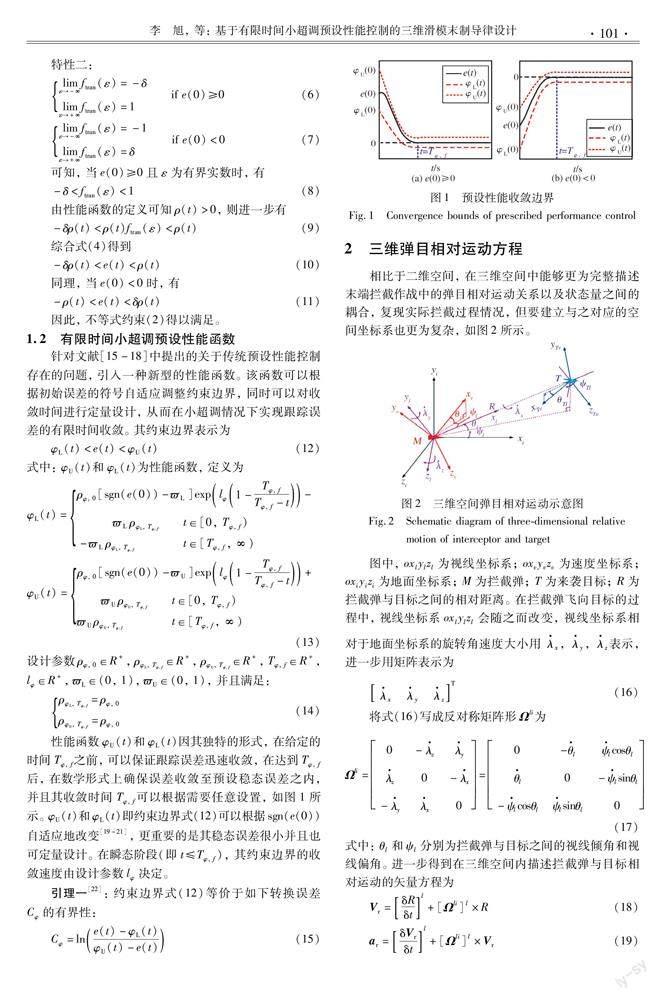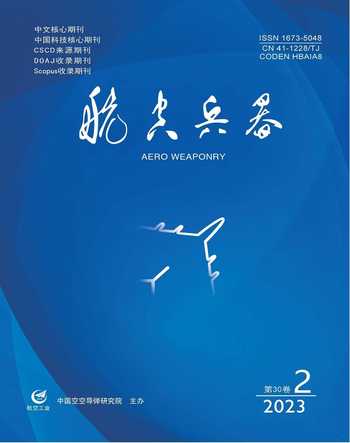基于有限时间小超调预设性能控制的三维滑模末制导律设计
李旭 叶继坤 邵雷 唐骁



摘要: 为了实现对高速机动目标的特定攻击角拦截, 本文结合控制领域的新型控制方法——有限时间小超调预设性能控制设计了新型三维滑模末制导律。 为了确保视线角和视线角速率能够在有限时间内收敛至期望值, 通过视线角偏差和视线角速率偏差构建了线性滑模面; 在趋近律设计上, 基于有限时间小超调预设性能控制分别设计了视线偏航平面和视线俯仰平面的制导指令, 保证跟踪误差可以按预设的收敛时间收敛, 并且超调量约束在较小范围内, 同时引入非线性有限时间观测器对制导指令中包含的目标加速度项进行估计, 进一步提高了制导精度。 通过仿真可知, 本文制导律可以实现不同拦截条件下对目标的特定攻击角拦截, 与现有的快速终端滑模制导律相比, 可以保证滑模变量在有限时间内小超调收敛, 同时实现特定角度打击, 拦截机动目标时脱靶量可以控制在1 m以下, 提升了系統的稳态性能和瞬态性能。
关键词: 预设性能控制; 有限时间小超调; 滑模控制; 三维末制导律; 攻击角约束; 机动目标; 拦截弹中图分类号: TJ765
文献标识码: A文章编号: 1673-5048(2023)02-0099-09
DOI: 10.12132/ISSN.1673-5048.2022.0102
0引言
随着航空航天以及制导控制领域相关技术的突破革新, 各种新型高速机动飞行器不断涌现, 世界各军事大国争相加快其研究与武器化进程。 高速机动飞行器凭借其优越的运行速度以及出色的机动能力躲避拦截弹, 进而顺利突防, 完成其既定作战任务。 以超声速巡航导弹、 再入式弹道导弹以及临近空间高超声速飞行器为代表的高速机动飞行器不仅飞行速度高, 可以达到马赫数3以上, 而且具备一定的快速进入空间能力和持续机动作战能力[1-2], 对传统的防空反导作战方式和理念提出了新的挑战。 在对来袭目标拦截的末制导段, 脱靶量即最终弹目相对距离, 通常用来作为衡量末制导律性能优劣的一个重要指标。 然而在拦截高速机动目标时, 为了提升拦截效果, 还要求拦截弹对目标实现直接碰撞或者以特定的撞击角度对目标实施撞击拦截, 以此来提高对目标的毁伤效果, 进一步提升拦截成功率。 因此, 考虑特定攻击角约束的三维制导律设计成为高速机动目标拦截领域的研究热点。
将攻击角约束等效转化为相应的终端视线角约束, 是目前对满足攻击角约束的制导律研究中最常见的方法[3]。 文献[4]针对以一定角度攻击运动目标问题, 定义了碰撞三角形概念, 提出一种采用偏置比例导引的间接撞击角度控制方法, 但制导律约束过多, 鲁棒性不强; 文献[5]提出一种基于非线性观测器的有限时间导引律, 使得弹目视线角可以在有限时间内收敛至期望值, 但由于其观测器的稳定性需要满足特定条件, 拦截大机动目标时误差较大; 文献[6]为了对弹目速度变化进行估计与补偿, 设计了自适应扩张状态观测器, 提出了一种考虑弹目速度时变的攻击角约束终端滑模导引律, 通过改进传统的指数趋近律削弱了系统抖振, 但其收敛时间无法定量设计。 在现代控制方法中, 滑模控制的鲁棒性优于传统控制方法, 并且在设计上易于实现, 基于此, 滑模控制方法在满足终端攻击角约束的制导律设计中得到了广泛应用。 利用滑模控制方法设计制导律通常需要考虑两个方面, 一是设计包含所有需要收敛的系统变量的滑模面, 现有研究中常用的滑模面形式有线性滑模面、 积分滑模面、 非奇异终端滑模面和分数阶滑模面等[7-9]; 二是设计趋近律保证所有滑模变量都可以快速收敛至滑模面, 其收敛性能由趋近律中的参数调节控制[10-11], 但是基于Lyapunov理论和有限时间收敛理论设计的滑模制导律, 不能保证相同参数在不同拦截环境下的收敛效果一致, 滑模变量的瞬态性能得不到有效保证。
考虑到在传统制导律设计中, 通常对拦截系统稳态性能的关注度远远大于瞬态性能, 而在高速机动目标的拦截过程中, 目标的高速飞行致使拦截弹末制导阶段的弹道调整时间大大缩短, 并且在高速飞行状态下, 即使目标的机动能力有限, 其机动半径也会被其飞行速度进一步放大, 这些都对制导律设计提出了新的要求。 制导控制系统必须在具备良好稳态性能的同时满足所期望的瞬态性能, 保证制导末段的拦截弹可以在要求时间内达到期望的飞行状态, 最终实现对高速机动目标的精确拦截打击。
目前, 控制领域出现了一种新兴控制方法——预设性能控制[12](Prescribed Performance Control, PPC), 由于其可以对系统瞬态性能施加良好的控制效果, 逐渐进入了学者的研究视线, 并且在飞行器控制领域崭露头角。 文献[13]为了解决挠性航天器在姿态跟踪上的控制问题, 将姿态跟踪误差作为收敛变量, 通过预设性能控制方法将跟踪误差限制在理想范围内, 大大提升了控制精度; 文献[14]为了解决基于非仿射模型的高超声速飞行器高度控制问题, 在控制器设计上融入预设性能控制思想, 既保证了高度控制系统具有良好的稳态精度, 同时在动态性能上也更加理想。 预设性能控制的核心思想就是保证被控制量可以按照提前设计的性能函数严格收敛至规定的收敛范围内, 既能保证系统跟踪误差收敛的稳态性能, 也可以对其瞬态性能进行约束。
预设性能控制方法在控制领域的应用已经初见成效, 但在制导领域的应用却少之又少, 由于其对于系统动态、 稳态性能的控制效果十分优越, 非常适用于拦截高速机动目标制导律的设计。 基于此, 本文将有限时间小超调预设性能控制应用于具有视线角约束的三维滑模末制导律设计中, 使滑模变量按照预设性能函数收敛, 并且收敛时间可以定量设计, 进一步提升制导律的稳态与瞬态性能, 实现对高速机动目标的有效拦截。
1有限时间小超调预设性能控制
常规的预设性能控制是指在收敛速度和超调量满足预先设定条件的前提下, 确保系统跟踪误差可以收敛到一个预先设定的任意小区域。 其不仅可以满足系统的瞬态性能和稳态性能, 还可以直接影响系统的控制性能, 但是传统的预设性能控制存在误差收敛时间无法定量设计的缺陷[15-16], 而文献[17-18]中提出的有限时间预设性能控制存在大超调问题。
1.1预设性能控制基础
1.2有限时间小超调预设性能函数
3基于有限时间小超调预设性能控制的末制导律设计
3.1视线俯仰平面制导律设计
3.2视线偏航平面制导律设计
3.3目标信息估计
在制导律表达式中存在目标加速度项, 然而在实际拦截过程中, 真实目标信息是无法单纯依靠导引头获取的, 同时在测得的目标信息中无法避免存在干扰噪聲, 利用非线性有限时间观测器[23](Nonlinear Disturbance Observe, NDO)对目标信息进行估计, 在这里只给出视线俯仰平面中的观测器具体形式。
4数值仿真
为验证上述所提基于有限时间小超调预设性能控制的三维滑模末制导律(Finite-Time and Small-Overshoot Prescribed Performance Control Guidance Law, FPPCG)的有效性, 本节首先分别在来袭目标作圆弧机动和螺旋机动两种情况下, 对FPPCG进行数字仿真, 验证其是否满足设计要求; 其次为了突出FPPCG的优越性以及制导特点, 在目标相同机动模式下与快速终端滑模制导律进行对比仿真。
(1) 同机动模式对比仿真
仿真步长取0.001 s, 拦截弹过载限制为±30g, 拦截弹与目标的初始参数设置如表1所示, FPPCG的相关参数设置如表2所示。
别为17.388 s与20.417 s, FPPCG能更快地实现对目标的精确打击, 在满足特定的攻击角约束的前提下确保拦截效果; 两种制导律的过载变化相比较而言, FPPCG的拦截弹过载更为平滑, 并且变化范围更小; 从视线角与视线角速率变化的对比曲线可以看出, FPPCG能够将两者在规定时间内约束至预设范围, 而FSTSMG因为目标的速度过大, 无法在拦截过程中实现对视线角和视线角速率的收敛, 导致该制导律作用下的脱靶量过大; 在滑模量控制方面, FPPCG作用下的滑模变量, 无论是其收敛的稳态性能还是动态性能都要优于FSTSMG, 并且其收敛精度和收敛速度都是基于预设参数可设计的, 除此之外, FSTSMG在制导末端的滑模变量会因为目标速度过大出现正负跳变, 不利于弹上机构实现控制指令。
5结论
为了适应新作战环境下防空反导作战任务的新要求, 解决高速机动目标的拦截难题, 实现对高速机动目标的特定攻击角拦截, 本文基于有限时间小超调预设性能控制设计了新型三维滑模末制导律。
(1) 在制导律设计中, 创新性结合有限时间小超调预设性能控制方法设计了滑模趋近律, 确保视线角与视线角速率能够在有限时间收敛至期望值, 同时满足收敛时间可调节的特点, 并且跟踪误差不会出现大超调。
(2) 为了减小制导律中未知干扰的影响, 设计了非线性有限时间观测器对制导指令中包含的目标加速度项进行估计, 进一步提高了FPPCG的制导精度。
通过仿真可知, 所设计的FPPCG可以在不同拦截条件下实现对滑模变量的有限时间小超调收敛, 进而保证对目标的特定攻击角拦截, 同时与现有快速终端滑模制导律相比较, 提升了系统的稳态性能和瞬态性能, 更加有利于工程实践。
参考文献:
[1] 张灿, 王轶鹏, 叶蕾. 国外近十年高超声速飞行器技术发展综述[J]. 战术导弹技术, 2020(6): 81-86.Zhang Can, Wang Yipeng, Ye Lei. Summary of the Technological Development of Overseas Hypersonics in the Past Ten Years[J]. Tactical Missile Technology, 2020(6): 81-86.(in Chinese)
[2] 叶喜发, 张欧亚, 李新其, 等. 国外高超声速巡航导弹的发展情况综述[J]. 飞航导弹, 2019(2): 65-68.Ye Xifa, Zhang Ouya, Li Xinqi, et al. Development of Hypersonic Cruise Missiles Abroad [J]. Aerodynamic Missile Journal, 2019(2): 65-68.(in Chinese)
[3] Chen Z Y, Chen W C, Liu X M, et al. Three-Dimensional Fixed-Time Robust Cooperative Guidance Law for Simultaneous Attack with Impact Angle Constraint[J]. Aerospace Science and Technology, 2021, 110: 106523.
[4] 黄诘, 张友安, 刘永新. 一种有撞击角和视场角约束的运动目标的偏置比例导引算法[J]. 宇航学报, 2016, 37(2): 195-202.Huang Jie, Zhang Youan, Liu Yongxin. A Biased Proportional Guidance Algorithm for Moving Target with Impact Angle and Field-of-View Constraints[J]. Journal of Astronautics, 2016, 37(2): 195-202.(in Chinese)
[5] 张良, 张泽旭, 郑博. 一种有攻击角约束的三维有限时间导引律[J]. 哈尔滨工业大学学报, 2018, 50(4): 8-14.Zhang Liang, Zhang Zexu, Zheng Bo. A Finite-Time Guidance Law for Three-Dimensional Terminal Interception with Impact Angle Constraints[J]. Journal of Harbin Institute of Technology, 2018, 50(4): 8-14.(in Chinese)
[6] 郭佳晖, 田宗浩, 蒋滨安, 等. 考虑弹目速度时变的攻击角约束终端滑模导引律[J]. 战术导弹技术, 2021(5): 87-93.Guo Jiahui, Tian Zonghao, Jiang Binan, et al. Terminal Sliding Mode Guidance Law with Impact Angle Constraint Considering Time-Varying Velocity of Missile and Target[J]. Tactical Missile Technology, 2021(5): 87-93.(in Chinese)
[7] Shao X Y, Sun G H, Xue C, et al. Nonsingular Terminal Sliding Mode Control for Free-Floating Space Manipulator with Disturbance[J]. Acta Astronautica, 2021, 181: 396-404.
[8] Hao L Y, Zhang Y Q, Li H. Fault-Tolerant Control via Integral Sliding Mode Output Feedback for Unmanned Marine Vehicles[J]. Applied Mathematics and Computation, 2021, 401: 126078.
[9] Ullah N. Fractional Order Sliding Mode Control Design for a Buck Converter Feeding Resistive Power Loads[J]. Mathematical Modelling of Engineering Problems, 2020, 7(4): 649-658.
[10] Zhao F J, You H. New Three-Dimensional Second-Order Sliding Mode Guidance Law with Impact-Angle Constraints[J]. The Aeronautical Journal, 2020, 124(1273): 368-384.
[11] Xu S, Gao M, Fang D, et al. A Novel Adaptive Second-Order Nonsingular Terminal Sliding Mode Guidance Law Design[J]. Journal of Aerospace Engineering, 2020, 234(16): 2263-2273.
[12] Li J, Ma K F, Wu Z J. Prescribed Performance Control for Uncertain Flexible-Joint Robotic Manipulators Driven by DC Motors[J]. International Journal of Control, Automation and Systems, 2021, 19(4): 1640-1650.
[13] 張超, 孙延超, 马广富, 等. 挠性航天器预设性能自适应姿态跟踪控制[J]. 哈尔滨工业大学学报, 2018, 50(4): 1-7.Zhang Chao, Sun Yanchao, Ma Guangfu, et al. Prescribed Performance Adaptive Attitude Tracking Control for Flexible Spacecraft[J]. Journal of Harbin Institute of Technology, 2018, 50(4): 1-7.(in Chinese)
[14] 李小兵, 赵思源, 王林. 基于非仿射模型的高超声速飞行器预设性能控制器[J]. 北京理工大学学报, 2020, 40(10): 1094-1101.Li Xiaobing, Zhao Siyuan, Wang Lin. Prescribed Performance Control for Hypersonic Flight Vehicles Based on Non-Affine Models[J]. Transactions of Beijing Institute of Technology, 2020, 40(10): 1094-1101.(in Chinese)
[15] Kostarigka A K, Rovithakis G A. Adaptive Dynamic Output Feedback Neural Network Control of Uncertain MIMO Nonlinear Systems with Prescribed Performance[J]. IEEE Transactions on Neural Networks and Learning Systems, 2012, 23(1): 138-149.
[16] Theodorakopoulos A, Rovithakis G A. A Simplified Adaptive Neural Network Prescribed Performance Controller for Uncertain MIMO Feedback Linearizable Systems[J]. IEEE Transactions on Neural Networks and Learning Systems, 2015, 26(3): 589-600.
[17] Zhao K, Song Y D, Ma T D, et al. Prescribed Performance Control of Uncertain Euler-Lagrange Systems Subject to Full-State Constraints[J]. IEEE Transactions on Neural Networks and Learning Systems, 2018, 29(8): 3478-3489.
[18] Liang H J, Zhang Y H, Huang T W, et al. Prescribed Perfor-mance Cooperative Control for Multiagent Systems with Input Quantization[J]. IEEE Transactions on Cybernetics, 2020, 50(5): 1810-1819.
[19] Qiu J B, Sun K K, Wang T, et al. Observer-Based Fuzzy Adaptive Event-Triggered Control for Pure-Feedback Nonlinear Systems with Prescribed Performance[J]. IEEE Transactions on Fuzzy Systems, 2019, 27(11): 2152-2162.
[20] 胡云安, 耿宝亮, 盖俊峰. 初始误差未知的不确定系统预设性能反演控制[J]. 华中科技大学学报:自然科学版, 2014, 42(8): 43-47.Hu Yunan, Geng Baoliang, Gai Junfeng. Prescribed Performance Backstepping Control for Uncertain Systems with Unknown Initial Errors[J]. Journal of Huazhong University of Science and Technology: Natural Science Edition, 2014, 42(8): 43-47.(in Chinese)
[21] Li Y M, Shao X F, Tong S C. Adaptive Fuzzy Prescribed Perfor-mance Control of Nontriangular Structure Nonlinear Systems[J]. IEEE Transactions on Fuzzy Systems, 2020, 28(10): 2416-2426.
[22] Bu X W, Qi Q, Jiang B X. A Simplified Finite-Time Fuzzy Neural Controller with Prescribed Performance Applied to Waverider Aircraft[J]. IEEE Transactions on Fuzzy Systems, 2022, 30(7): 2529-2537.
[23] 韓吉霞, 马飞越, 佃松宜, 等. 基于非线性干扰观测器不确定系统的终端滑模控制[J]. 电光与控制, 2020, 27(2): 29-34.Han Jixia, Ma Feiyue, Dian Songyi, et al. Terminal Sliding Mode Control for Uncertain Systems Based on Nonlinear Disturbance Observer[J]. Electronics Optics & Control, 2020, 27(2): 29-34.(in Chinese)
[24] 蒲明, 吴庆宪, 姜长生, 等. 高阶滑模微分器的分析与改进[J]. 控制与决策, 2011, 26(8): 1136-1140.Pu Ming, Wu Qingxian, Jiang Changsheng, et al. Analysis and Improvement of Higher-Order Sliding Mode Differentiator[J]. Control and Decision, 2011, 26(8): 1136-1140.(in Chinese)
[25] 卜祥偉, 吴晓燕, 陈永兴, 等. 基于非线性干扰观测器的高超声速飞行器滑模反演控制[J]. 控制理论与应用, 2014, 31(11): 1473-1479.Bu Xiangwei, Wu Xiaoyan, Chen Yongxing, et al. Nonlinear-Disturbance-Observer-Based Sliding Mode Backstepping Control of Hypersonic Vehicles[J]. Control Theory & Applications, 2014, 31(11): 1473-1479.(in Chinese)
[26] 王宇航, 姚郁, 马克茂. Fal函数滤波器的分析及应用[J]. 电机与控制学报, 2010, 14(11): 88-91.Wang Yuhang, Yao Yu, Ma Kemao. Analysis and Application of Fal Function Filter[J]. Electric Machines and Control, 2010, 14(11): 88-91.(in Chinese)
[27] 李军, 廖宇新, 李珺. 三维自适应有限时间超螺旋滑模制导律[J]. 系统工程与电子技术, 2021, 43(3): 779-788.Li Jun, Liao Yuxin, Li Jun. Three-Dimensional Adaptive Finite-Time Super-Twisting Sliding Mode Guidance Law[J]. Systems Engineering and Electronics, 2021, 43(3): 779-788.(in Chinese)
Design of Three Dimensional Sliding Mode Terminal Guidance Law
Based on Finite-Time and Small-Overshoot
Prescribed Performance Control
Li Xu Ye Jikun Shao Lei Tang Xiao
(1. Graduate School, Air Force Engineering University, Xian 710051, China;
2. Air and Missile Defense College, Air Force Engineering University, Xian 710051, China)
Abstract: In order to intercept a high-speed maneuvering target at a specific attack angle, a three dimensional sliding mode terminal guidance law is designed based on finite-time and small-overshoot prescribed performance control, which is a new method in control field. The linear sliding surface is designed based on the angle of sight deviation and angle of sight rate deviation to ensure that the angle of sight and angle of sight rate converge to the expected value in finite time. On reaching law design, guidance instructions for the yaw plane and pitch plane are designed respectively based on the finite-time and small-overshoot prescribed performance control, ensuring that the tracking error can converge at a preset convergence time and the overshoot is constrained to a small range. At the same time, the nonlinear finite-time observer is introduced to estimate the target acceleration term in the guidance instruction to further improve the guidance accuracy. The simulation results show that the proposed guidance law can intercept targets at specific attack angle under different interception conditions. Compared with the existing fast terminal sliding mode guidance law, the proposed guidance law can guarantee the small-overshoot convergence of sliding mode variables in finite time, and can strike the target form the specific angle. When intercepting maneuvering targets, the miss distance can be controlled below 1 m, improving the steady-state performance and transient performance of the system.
Key words: prescribed performance control(PPC); finite-time and small-overshoot; sliding mode control; three dimensional terminal guidance law; angle of attack constrain; maneuvering target; interceptor

